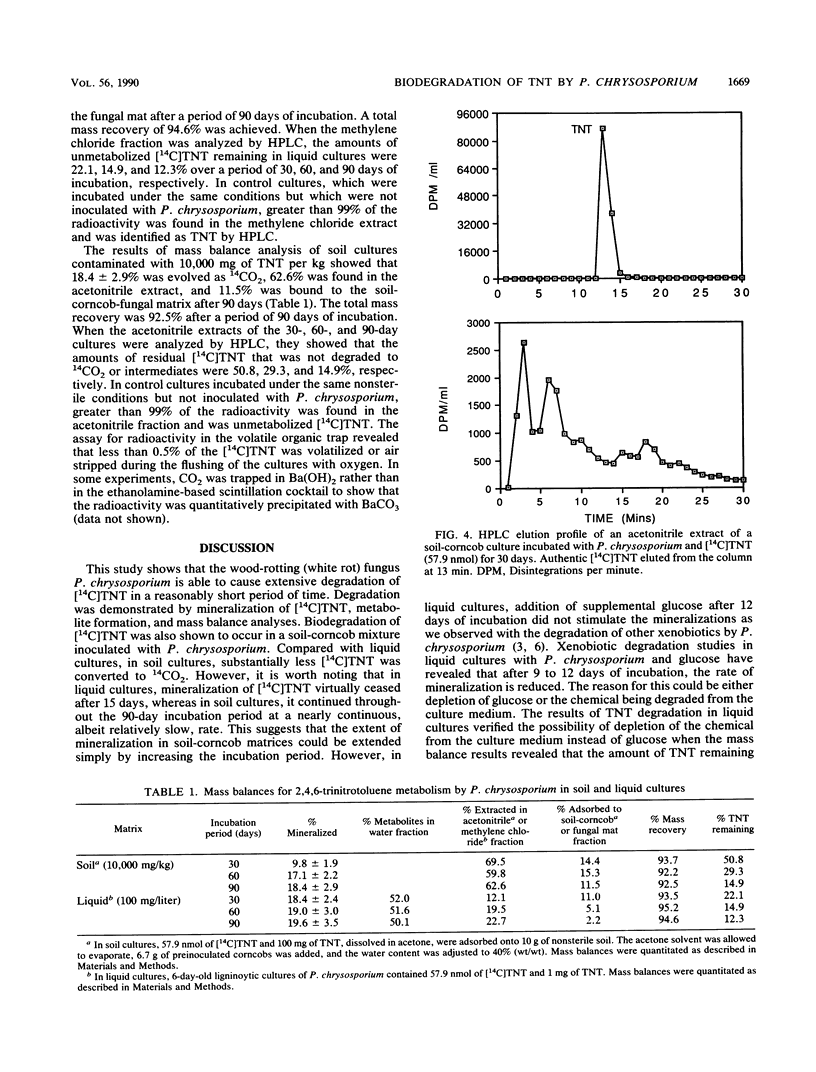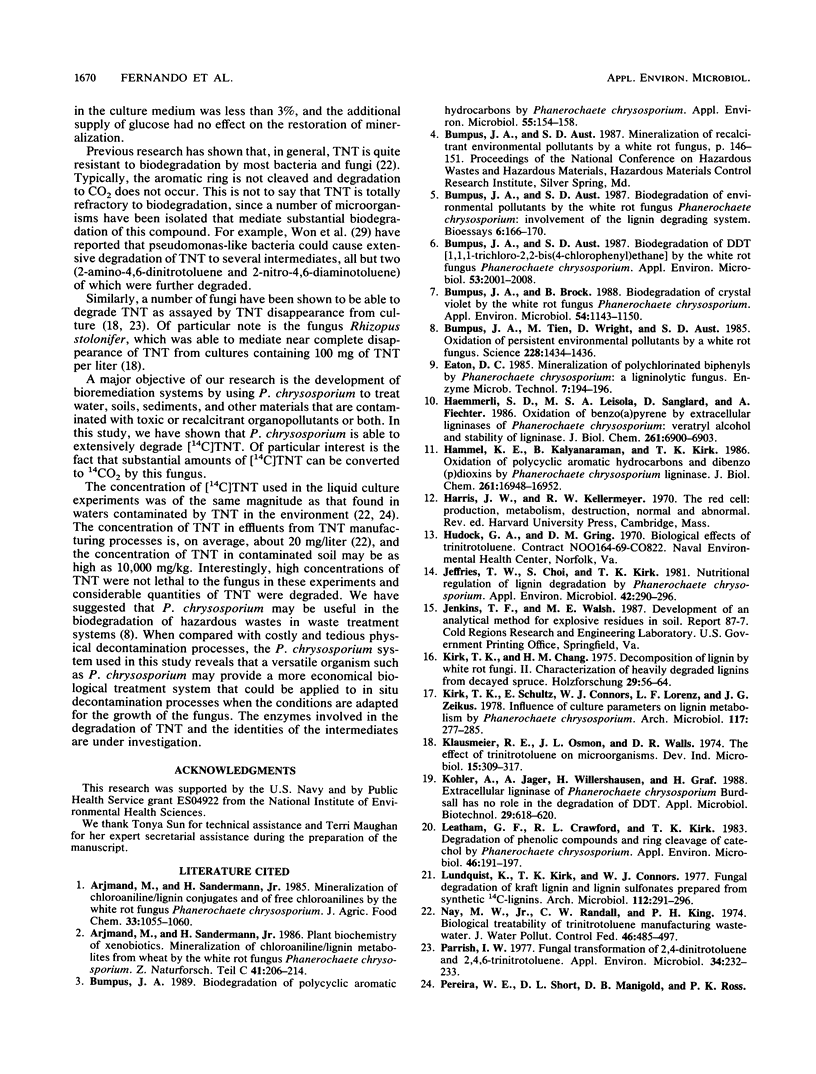Abstract
Extensive biodegradation of TNT (2,4,6-trinitrotoluene) by the white rot fungus Phanerochaete chrysosporium was observed. At an initial concentration of 1.3 mg/liter, 35.4 +/- 3.6% of the [14C]TNT was degraded to 14CO2 in 18 days. The addition of glucose 12 days after the addition of TNT did not stimulate mineralization, and, after 18 days of incubation with TNT only, about 3.3% of the initial TNT could be recovered. Mineralization of [14C]TNT adsorbed on soil was also examined. Ground corncobs served as the nutrient for slow but sustained degradation of [14C]TNT to 14CO2 such that 6.3 +/- 0.6% of the [14C]TNT initially present was converted to 14CO2 during the 30-day incubation period. Mass balance analysis of liquid cultures and of soil-corncob cultures revealed that polar [14C]TNT metabolites are formed in both systems, and high-performance liquid chromatography analyses revealed that less than 5% of the radioactivity remained as undegraded [14C]TNT following incubation with the fungus in soil or liquid cultures. When the concentration of TNT in cultures (both liquid and soil) was adjusted to contamination levels that might be found in the environment, i.e., 10,000 mg/kg in soil and 100 mg/liter in water, mineralization studies showed that 18.4 +/- 2.9% and 19.6 +/- 3.5% of the initial TNT was converted to 14CO2 in 90 days in soil and liquid cultures, respectively. In both cases (90 days in water at 100 mg/liter and in soil at 10,000 mg/kg) approximately 85% of the TNT was degraded. These results suggest that this fungus may be useful for the decontamination of sites in the environment contaminated with TNT.
Full text
PDF





Selected References
These references are in PubMed. This may not be the complete list of references from this article.
- Bumpus J. A., Aust S. D. Biodegradation of DDT [1,1,1-trichloro-2,2-bis(4-chlorophenyl)ethane] by the white rot fungus Phanerochaete chrysosporium. Appl Environ Microbiol. 1987 Sep;53(9):2001–2008. doi: 10.1128/aem.53.9.2001-2008.1987. [DOI] [PMC free article] [PubMed] [Google Scholar]
- Bumpus J. A. Biodegradation of polycyclic hydrocarbons by Phanerochaete chrysosporium. Appl Environ Microbiol. 1989 Jan;55(1):154–158. doi: 10.1128/aem.55.1.154-158.1989. [DOI] [PMC free article] [PubMed] [Google Scholar]
- Bumpus J. A., Brock B. J. Biodegradation of crystal violet by the white rot fungus Phanerochaete chrysosporium. Appl Environ Microbiol. 1988 May;54(5):1143–1150. doi: 10.1128/aem.54.5.1143-1150.1988. [DOI] [PMC free article] [PubMed] [Google Scholar]
- Bumpus J. A., Tien M., Wright D., Aust S. D. Oxidation of persistent environmental pollutants by a white rot fungus. Science. 1985 Jun 21;228(4706):1434–1436. doi: 10.1126/science.3925550. [DOI] [PubMed] [Google Scholar]
- Haemmerli S. D., Leisola M. S., Sanglard D., Fiechter A. Oxidation of benzo(a)pyrene by extracellular ligninases of Phanerochaete chrysosporium. Veratryl alcohol and stability of ligninase. J Biol Chem. 1986 May 25;261(15):6900–6903. [PubMed] [Google Scholar]
- Hammel K. E., Kalyanaraman B., Kirk T. K. Oxidation of polycyclic aromatic hydrocarbons and dibenzo[p]-dioxins by Phanerochaete chrysosporium ligninase. J Biol Chem. 1986 Dec 25;261(36):16948–16952. [PubMed] [Google Scholar]
- Jeffries T. W., Choi S., Kirk T. K. Nutritional Regulation of Lignin Degradation by Phanerochaete chrysosporium. Appl Environ Microbiol. 1981 Aug;42(2):290–296. doi: 10.1128/aem.42.2.290-296.1981. [DOI] [PMC free article] [PubMed] [Google Scholar]
- Leatham G. F., Crawford R. L., Kirk T. K. Degradation of Phenolic Compounds and Ring Cleavage of Catechol by Phanerochaete chrysosporium. Appl Environ Microbiol. 1983 Jul;46(1):191–197. doi: 10.1128/aem.46.1.191-197.1983. [DOI] [PMC free article] [PubMed] [Google Scholar]
- Nay M. W., Jr, Randall C. W., King P. H. Biological treatability of trinitrotoluene manufacturing wastewater. J Water Pollut Control Fed. 1974 Mar;46(3):485–497. [PubMed] [Google Scholar]
- Parrish F. W. Fungal transformation of 2,4-dinitrotoluene and 2,4,6-trinitrotoluene. Appl Environ Microbiol. 1977 Aug;34(2):232–233. doi: 10.1128/aem.34.2.232-233.1977. [DOI] [PMC free article] [PubMed] [Google Scholar]
- Won W. D., DiSalvo L. H., Ng J. Toxicity and mutagenicity of 2,4,-6-trinitrotoluene and its microbial metabolites. Appl Environ Microbiol. 1976 Apr;31(4):576–580. doi: 10.1128/aem.31.4.576-580.1976. [DOI] [PMC free article] [PubMed] [Google Scholar]
- Won W. D., Heckly R. J., Glover D. J., Hoffsommer J. C. Metabolic disposition of 2,4,6-trinitrotoluene. Appl Microbiol. 1974 Mar;27(3):513–516. doi: 10.1128/am.27.3.513-516.1974. [DOI] [PMC free article] [PubMed] [Google Scholar]


